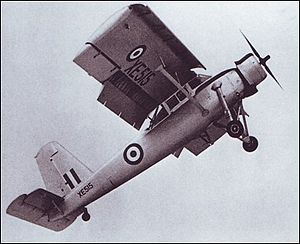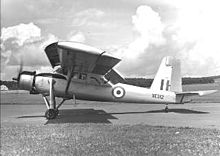Scottish Aviation Pioneer Video - Picture

|
|
Scottish Aviation Pioneer

Role: Utility transport
Manufacturer: Scottish Aviation
First flight: 5 November 1947
Introduced: 1950
Retired: 1969 (RAF)
Primary users: Royal Air Force
Malaysia
Ceylon
Number built: 59
Variants: Scottish Aviation Twin Pioneer
The Scottish Aviation Pioneer was a STOL aircraft manufactured by Scottish Aviation in Scotland. It was used for casualty evacuation and communications and could accommodate a pilot and up to five passengers.
Design and development
The Pioneer was planned to meet the requirements of Air Ministry Specification A.4/45 for a light communication aircraft. The three-seat prototype A4/45, powered by a 240 hp de Havilland Gipsy Queen was a three-seat high-winged cabin monoplane. Four prototypes were ordered, under the name "Scottish Aviation Prestwick Pioneer" (Serials VL515, VL516, VL517, and VL518). In the event, only the first two were completed. The prototype aircraft (VL515) first flew in 1947.
The use of the Gipsy Queen engine resulted in disappointing performance, and so the A.4/45 was not ordered by the RAF. Scottish Aviation decided instead to produce a civil version. This was achieved by fitting the two prototypes (VL515 and VL516) with new, more powerful engines as the "Pioneer II"
The prototype Pioneer II was the former prototype Pioneer I, (VL515) which was civil registered as G-AKBF. Powered by a 520 hp Alvis Leonides engine, and first flew on 5 May 1950. The second prototype Pioneer I (VL516) was similarly converted, and civil registered as G-ANAZ. . The Pioneer II demonstrated excellent STOL performance, and was ordered by the RAF as the Pioneer CC.1.
The first Pioneer CC.1 to be delivered to the RAF was serialled XE512, which was delivered on 11 August 1953. Ironically, XE512 was essentially the prototype Prestwick Pioneer I from 1947, re-engined with the Alvis Leonides engine, and refurbished for RAF use. (Thus, VL515 became G-AKBZ, and then returned to a military serial as XE512). The next three aircraft delivered (constructors numbers 102, 103 and 104) were likewise the second prototype VL516/G-ANAZ plus the partly completed third and fourth prototypes VL517 and VL518). As XE513, XE514 and XE515 they were delivered on 15 August 1953, 3 September 1953 and 10 February 1954 respectively. Two of these first batch of four are illustrated on this page.
Operational history
The RAF used the Pioneer extensively for tasks such as casualty evacuation in the Malayan Emergency, Aden and Cyprus. With its unusually large slats and flaps, it was able to operate out of very short, unprepared strips and could take off in as little as 225 ft. The Pioneer remained operational in small numbers until 1969 . Pioneers were also used by the Royal Ceylon Air Force and the Royal Malayan Air Force.
The sole surviving Pioneer CC.1 is serial number XL703, the third from last aircraft, which was delivered to the RAF on 18 December 1956, and has been preserved by the RAF Museum since October 1968. It has been displayed by the RAF Museum at Cosford since April 1989 (See http://www.rafmuseum.org.uk/cosford/collections/aircraft/aircraft_histories/69-A-186%20Pioneer%20CC1%20XL703.pdf )
Variants
Pioneer : Four-seat STOL transport aircraft, powered by a 240-hp (179-kW) de Havilland Gipsy Queen 32 piston engine.
Pioneer 2 : Five-seat STOL transport aircraft, powered by a 520-hp (388-kW) Alvis Leonides radial piston engine.
Pioneer CC Mk 1 : Five-seat STOL casualty evacuation, communications aircraft for the RAF.
Operators

Picture - RAF Scottish Aviation Pioneer
Sri Lanka (Ceylon)
Royal Ceylon Air Force - (six aircraft, originally ordered for the RAF as serial numbers XL668 to XL674 inclusive, but diverted whilst under construction to fulfil the Royal Ceylon Air Force order)
Malaysia
Royal Malaysian Air Force - (nine aircraft)
Oman
Royal Air Force of Oman
United Kingdom
Royal Air Force
No. 20 Squadron RAF
No. 78 Squadron RAF
No. 209 Squadron RAF
No. 215 Squadron RAF
No. 230 Squadron RAF
No. 267 Squadron RAF
Specifications (Pioneer CC.1)
Data from Aircraft of the Royal Air Force
General characteristics
Crew: One
Capacity: Four passengers
Length: 34 ft 4 in (10.47 m)
Wingspan: 49 ft 9 in (15.17 m)
Height: 10 ft 3 in (3.13 m)
Wing area: 390 ft² (36.3 m²)
Empty weight: 3,835 lb (1,743 kg)
Loaded weight: 5,800 lb (2,636 kg)
Powerplant: 1 x— Alvis Leonides 502/4 radial engine, 520 hp (388 kW)
Performance
Maximum speed: 141 knots (162 mph, 261 km/h)
Cruise speed: 105 knots (121 mph, 195 km/h)
Stall speed: 31 knots (36 mph, 58 km/h)
Range: 365 nm (420 mi, 676 km)
Service ceiling: 23,000 ft (7,010 m)
Wing loading: 14.9 lb/ft² (72.6 kg/m²)
Power/mass: 0.0897 hp/lb (0.147 kW/kg)
Take off run 225 ft (69 m)
Landing run 198 ft (60 m)
Related development
Scottish Aviation Twin Pioneer
Comparable aircraft
Helio Courier
Scottish Aviation Pioneer Pictures
More airplane videos.
Source: WikiPedia